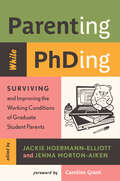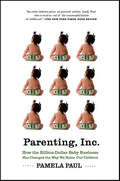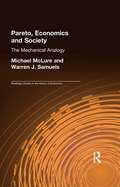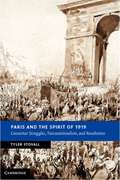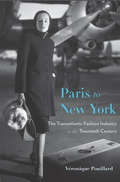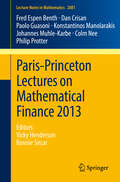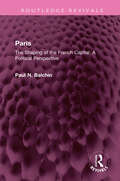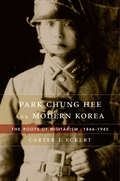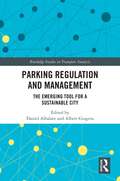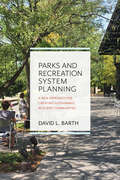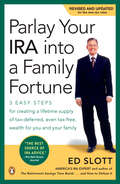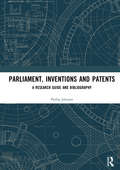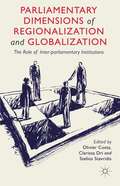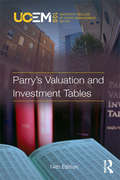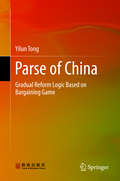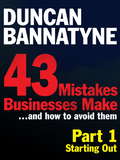- Table View
- List View
Parenting Magazine
by William A. SahlmanDescribes a set of decisions confronting Robin Wolaner, who is negotiating with representatives of Time Inc. about investing in a project to launch a new magazine called Parenting. The negotiations have reached an impasse. Among the issues to be considered are the following: 1) How do you assess the opportunity that Wolaner has identified? 2) How much money does Wolaner need? From whom should the capital be raised? 3) Is the proposed deal with Time Inc. reasonable? From whose perspective? What changes, if any, should be made to the deal? 4) What should Wolaner do?
Parenting While PhDing: Surviving and Improving the Working Conditions of Graduate Student Parents
by Jackie Hoermann-Elliott Jenna Morton-AikenBeing a PhD student is not easy. Navigating the highly competitive world of academia while working hard for little or no pay would be stressful for anyone—but it’s especially challenging for graduate students who are also parents. Featuring contributions from more than forty current and former graduate students raising children, Parenting While PhDing offers valuable advice for students and administrators. Parents will get practical recommendations on both child care and self-care, learning how to form supportive personal and professional networks while establishing a healthy work/life balance. The collection also offers thoughtful suggestions on how to make graduate programs less toxic and more inclusive. Recognizing that not all graduate students have similar backgrounds or needs, Parenting While PhDing features a diverse range of viewpoints, including queer, trans, disabled, BIPOC, immigrant, and first-generation college students. The authors represent a variety of disciplines, from the natural and social sciences to the humanities and health care professions. Together, they share fresh perspectives on the experiences of graduate students with children and offer strategies they can use to navigate the dual pressures of the academy and parenting.
Parenting, Inc.: How the Billion-Dollar Baby Business Has Changed the Way We Raise Our Children
by Pamela PaulA leading social critic goes inside the billion-dollar baby business to expose the marketing and the myths, helping parents determine what's worth their money—and what's a wasteParenting coaches, ergonomic strollers, music classes, sleep consultants, luxury diaper creams, a never-ending rotation of DVDs that will make a baby smarter, socially adept, and bilingual before age three. Time-strapped, anxious parents hoping to provide the best for their baby are the perfect mark for the "parenting" industry.In Parenting, Inc., Pamela Paul investigates the whirligig of marketing hype, peer pressure, and easy consumerism that spins parents into purchasing overpriced products and raising overprotected, overstimulated, and over-provided-for children. Paul shows how the parenting industry has persuaded parents that they cannot trust their children's health, happiness, and success to themselves. She offers a behind-the-scenes look at the baby business so that any parent can decode the claims—and discover shockingly unuseful products and surprisingly effective services. And she interviews educators, psychologists, and parents to reveal why the best thing for a baby is to break the cycle of self-recrimination and indulgence that feeds into overspending.Paul's book leads the way for every parent who wants to escape the spiral of fear, guilt, competition, and consumption that characterizes modern American parenthood.
Parentonomics: An Economist Dad Looks at Parenting (The\mit Press Ser.)
by Joshua GansWhat every parent needs to know about negotiating, incentives, outsourcing, and other strategies to solve the economic management problem that is parenting. Like any new parent, Joshua Gans felt joy mixed with anxiety upon the birth of his first child. Who was this blanket-swaddled small person and what did she want? Unlike most parents, however, Gans is an economist, and he began to apply the tools of his trade to raising his children. He saw his new life as one big economic management problem—and if economics helped him think about parenting, parenting illuminated certain economic principles. Parentonomics is the entertaining, enlightening, and often hilarious fruit of his “research.” Incentives, Gans shows us, are as risky in parenting as in business. An older sister who is recruited to help toilet train her younger brother for a share in the reward given for each successful visit to the bathroom, for example, could give the trainee drinks of water to make the rewards more frequent. (Economics later offered another, better toilet training solution: outsourcing. For their third child, Gans and his wife put it in the hands of professionals—the day care providers.) Gans gives us the parentonomic view of delivery (if the mother shares her pain by yelling at the father, doesn't it really create more aggregate pain?), sleep (the screams of a baby are like an offer: “I'll stop screaming if you give me attention”), food (a question of marketing), travel (“the best thing you can say about traveling with children is that they are worse than baggage”), punishment (and threat credibility), birthday party time management, and more. Parents: if you're reading Parentonomics in the presence of other people, you'll be unable to keep yourself from reading the funny parts out loud. And if you're reading it late at night and wake a child with your laughter—well, you'll have some guidelines for negotiating a return to bed.
Pareto, Economics and Society: The Mechanical Analogy (Routledge Studies in the History of Economics #Vol. 46)
by Michael McLureVilfredo Pareto was one of the great systems theorists of the twentieth century, embracing economics, psychology, sociology and politics. In this important work, Michael McLure takes as his subject of study the rapport between Pareto's economic and sociological theory, and consequently, illuminates the role of economics in public policy development.
Paris Saint-Germain: Building One of the World's Top Sports Brands
by Anita Elberse David Moreno VicenteIn March 2020, Nasser Al-Khelaifi, the president of French soccer club Paris Saint-Germain ('PSG') sees his team clinch a spot among the last eight clubs to compete in the UEFA Champions League. Established in 1970 and initially a club with only moderate success, PSG's fortunes changed when Qatar Sports Investments (QSI) acquired the club in 2011. QSI overhauled the roster of players-by, among other measures, buying Kylian Mbapp and, in a record 222-million transfer that shook the soccer world, Neymar-and professionalized the club's management, renovated the stadium, developed a new training ground, redefined the PSG brand, and pursued a series of high-profile collaborations. The investment seems to have paid off, on and off the field: since the acquisition, PSG has amassed six French league titles and has risen to fifth place in the ranking of Europe's highest-grossing soccer clubs. But the biggest prize the club's owners are eyeing, the Champions League, has so far eluded PSG. Does the club have the right strategy to break the hegemony of Europe's long-standing soccer powerhouses? And are Al-Khelaifi and his team of executives on the right path toward their goal of establishing PSG as one of the world's top three sports brands?
Paris and the Spirit of 1919
by Tyler StovallThis transnational history of Paris in 1919 explores the global implications of the revolutionary crisis of French society at the end of World War I. As the site of the peace conference Paris was a victorious capital and a city at the center of the world, and Tyler Stovall explores these intersections of globalization and local revolution. The book takes as its central point the eruption of political activism in 1919, using the events of that year to illustrate broader tensions in working class, race, and gender politics in Parisian, French, and ultimately global society which fueled debates about colonial subjects and the empire. Viewing consumerism and consumer politics as key both to the revolutionary crisis and to new ideas about working class identity, and arguing against the idea that consumerism depoliticized working people, this history of local labor movements is a study in the making of the modern world.
Paris to New York: The Transatlantic Fashion Industry in the Twentieth Century (Harvard studies in business history)
by Véronique PouillardAn innovative history of the fashion industry, focusing on the connections between Paris and New York, art and finance, and design and manufacturing. Fashion is one of the most dynamic industries in the world, with an annual retail value of $3 trillion and globally recognized icons like Coco Chanel, Christian Dior, and Yves Saint Laurent. How did this industry generate such economic and symbolic capital? Focusing on the roles of entrepreneurs, designers, and institutions in fashion’s two most important twentieth-century centers, Paris to New York tells the history of the industry as a negotiation between art and commerce. In the late nineteenth century, Paris-based firms set the tone for a global fashion culture nurtured by artistic visionaries. In the burgeoning New York industry, however, the focus was on mass production. American buyers, trend scouts, and designers crossed the Atlantic to attend couture openings, where they were inspired by, and often accused of counterfeiting, designs made in Paris. For their part, Paris couturiers traveled to New York to understand what American consumers wanted and to make deals with local manufacturers for whom they designed exclusive garments and accessories. The cooperation and competition between the two continents transformed the fashion industry in the early and mid-twentieth century, producing a hybrid of art and commodity. Véronique Pouillard shows how the Paris–New York connection gave way in the 1960s to a network of widely distributed design and manufacturing centers. Since then, fashion has diversified. Tastes are no longer set by elites alone, but come from the street and from countercultures, and the business of fashion has transformed into a global enterprise.
Paris-Princeton Lectures on Mathematical Finance 2013
by Dan Crisan Johannes Muhle-Karbe Colm Nee Konstantinos Manolarakis Philip Protter Fred Espen Benth Vicky Henderson Paolo Guasoni Ronnie SircarThe current volume presents four chapters touching on some of the most important and modern areas of research in Mathematical Finance: asset price bubbles (by Philip Protter); energy markets (by Fred Espen Benth); investment under transaction costs (by Paolo Guasoni and Johannes Muhle-Karbe); and numerical methods for solving stochastic equations (by Dan Crisan, K. Manolarakis and C. Nee).The Paris-Princeton Lecture Notes on Mathematical Finance, of which this is the fifth volume, publish cutting-edge research in self-contained, expository articles from renowned specialists. The aim is to produce a series of articles that can serve as an introductory reference source for research in the field.
Paris: The Shaping of the French Capital A Political Perspective (Routledge Revivals)
by Paul N. BalchinThis book offers a new perspective on French architecture, describing the impact of political history on the architectural development of Paris. Through various stages in history from the Roman to the Medieval, Renaissance and Early Modern and Modern, Paris: The Shaping of the French Capital shows how the immense political power of monarchs, the aristocracy and church determined the pace and volume of building in Paris and the extent of town planning. Whereas many other great cities owe their historic importance to trade, and to local government (the City of London being a supreme example), these attributes were largely absent in Paris (throughout most of its history it didn’t even have a mayor). Arguably, because of this, gradually over the centuries the French capital emerged as one of the world’s most beautiful cities, and now is a metropolis with a population in excess of 2 million.
Paris: The Shaping of the French Capital A Political Perspective (Routledge Revivals)
by Paul N. BalchinThis book offers a new perspective on French architecture, describing the impact of political history on the architectural development of Paris. Through various stages in history from the Roman to the Medieval, Renaissance and Early Modern and Modern, Paris: The Shaping of the French Capital shows how the immense political power of monarchs, the aristocracy and church determined the pace and volume of building in Paris and the extent of town planning. Whereas many other great cities owe their historic importance to trade, and to local government (the City of London being a supreme example), these attributes were largely absent in Paris (throughout most of its history it didn’t even have a mayor). Arguably, because of this, gradually over the centuries the French capital emerged as one of the world’s most beautiful cities, and now is a metropolis with a population in excess of 2 million.
Park Chung Hee and Modern Korea: The Roots of Militarism, 1866–1945
by Carter J. EckertThis first volume in a two-part study examines the origins of South Korean authoritarianism as personified by the militant political leader. For South Koreans, the twenty years from the early 1960s to late 1970s were the best and worst of times—a period of unprecedented economic growth and of political oppression that deepened as prosperity spread. In this masterly account, Carter J. Eckert finds the roots of South Korea&’s dramatic socioeconomic transformation in the country&’s long history of militarization—a history personified in South Korea&’s paramount leader, Park Chung Hee. In Park Chung Hee and Modern Korea, Eckert reveals how the foundations of Park&’s leadership were established during the period of Japanese occupation. As a cadet in the Manchurian Military Academy, Park and his fellow officers absorbed the Imperial Japanese Army&’s ethos of victory at all costs and absolute obedience to authority. When Park seized power in 1961, he applied this ethos to the project of Korean modernization. Korean society under Park exuded a distinctively martial character, Eckert shows. Its hallmarks included the belief that the army should intervene in politics in times of crisis; that a central authority should manage the country&’s economic system; and that the state should maintain a strong disciplinary presence in society, reserving the right to use violence to maintain order.&“A milestone in the literature of modern East Asia.&” ―Bruce Cumings, author of Korea&’s Place in the Sun
Parker Biscuits, Inc.: Venturing into China
by Ann E. GrayCarol Wittenberg's first major task as president of the Asia/Pacific business for Parker's Biscuits is to set up a joint venture to manufacture biscuits in China. The team that Wittenberg has put together to find a joint venture partner has narrowed the choice down to two quite different Chinese enterprises. One partner is larger, has broader product lines, and offers a better estimated financial payback on the investment. The other appears to be much more open to Parker's manufacturing management methods. Either choice will represent the company's largest single investment in a joint venture to date.
Parking Regulation and Management: The Emerging Tool for a Sustainable City (Routledge Studies in Transport Analysis)
by Daniel Albalate and Albert GrageraContaining some of the most recent and original studies on parking regulation and management from different disciplines, this book offers rigorous analysis from top researchers with a clear intention to deliver policy implications and provide information to the public. The book is organized according to a variety of key topics. Among others, it covers the interaction of parking with other modes of transportation and its demand, its pricing and external effects, the role of information and digitalization, and the effects of regulation and its enforcement. Also, it includes the views of practitioners, who discuss present parking in cities and the future of its management. Written primarily for scholars interested in transportation, mobility, planning and urban affairs, this book is also directly relevant to practitioners and policymakers in government with responsibilities in mobility. Additionally, the book will be of interest to the private sector as it offers a practical link between rigorous academic analyses and the needs of practitioners.
Parks and Recreation System Planning: A New Approach for Creating Sustainable, Resilient Communities
by David BarthParks and recreation systems have evolved in remarkable ways over the past two decades. No longer just playgrounds and ballfields, parks and open spaces have become recognized as essential green infrastructure with the potential to contribute to community resiliency and sustainability. To capitalize on this potential, the parks and recreation system planning process must evolve as well. In Parks and Recreation System Planning, David Barth provides a new, step-by-step approach to creating parks systems that generate greater economic, social, and environmental benefits.Barth first advocates that parks and recreation systems should no longer be regarded as isolated facilities, but as elements of an integrated public realm. Each space should be designed to generate multiple community benefits. Next, he presents a new approach for parks and recreation planning that is integrated into community-wide issues. Chapters outline each step—evaluating existing systems, implementing a carefully crafted plan, and more—necessary for creating a successful, adaptable system. Throughout the book, he describes initiatives that are creating more resilient, sustainable, and engaging parks and recreation facilities, drawing from his experience consulting in more than 100 communities across the U.S.Parks and Recreation System Planning meets the critical need to provide an up-to-date, comprehensive approach for planning parks and recreation systems across the country. This is essential reading for every parks and recreation professional, design professional, and public official who wants their community to thrive.
Parks and Recreation and Economics (Routledge Economics and Popular Culture Series)
by Jadrian WootenThis book provides an in-depth look at the primary foundations of economics explored through the lens of the Pawnee Department of Parks and Recreation. Each episode of the hit television series, Parks and Recreation, includes material to help an eager learner understand the basics of one of the most fascinating fields of study. Whether you’ve wondered how economists determine specialization or why fast-food restaurants continue to pop up around your neighborhood, the same situations have occurred in Pawnee. Each chapter highlights key scenes or major episodes that demonstrate how the characters experience economics in exactly the same way the rest of us do. This text primarily builds on the debates that take place between Leslie, Ron, and their co-workers, while also exploring key questions such as whether governments should try to help people through direct intervention or sell off all the swings to private corporations and let businesses handle day-to-day decisions. Learn how incentives can make Jerry appear to be a more productive employee short-term, but end up causing chaos. Do you wonder what it would be like to live in the early 1800s? Thankfully Leslie has already done that for us. This book is a must-read for anyone looking for a fun way to learn the principles of economics, including as a supplementary text, and for all fans of Parks and Recreation. Take the advice of Tom and Donna and treat yo’ self to this key read.
Parlay Your IRA into a Family Fortune: 3 Easy Steps for Creating a Lifetime Supply of Tax-Deferred, Even Tax-Free, Wealth for You and Your Family
by Ed Slott"America 's IRA expert"(Mutual Funds magazine) Ed Slott shows readers how to make the most out of their retirement plans. ? Achieve unlimited tax-free income after retirement and keep assets in the family ? Protect retirement funds from creditors, divorce, bankruptcy, lawsuits, or other problems that could expose it to loss ? Use a Roth IRA to build a tax-free fortune Slott's three-step strategy cuts through the tax laws and provides simple, easy-to-follow instructions for managing IRAs and other retirement income.
Parliament, Inventions and Patents: A Research Guide and Bibliography
by Phillip JohnsonThis book is a research guide and bibliography of Parliamentary material, including the Old Scottish Parliament and the Old Irish Parliament, relating to patents and inventions from the early seventeenth century to 1976. It chronicles the entire history of a purely British patent law before the coming into force of the European Patent Convention under the Patents Act 1977. It provides a comprehensive record of every Act, Bill, Parliamentary paper, report, petition and recorded debate or Parliamentary question on patent law during the period. The work will be an essential resource for scholars and researchers in intellectual property law, the history of technology, and legal and economic history.
Parliamentary Dimensions of Regionalization and Globalization
by Olivier Costa Clarissa Dri Stelios StavridisThe end of the Cold War has seen an international proliferation of parliamentary bodies of all types and at all levels. How can this process of parliamentarization be assessed and under what conditions do these institutions operate? This book explores how regional integration and globalization are developing from a parliamentary perspective.
Parmalat Uruguay (A)
by Gustavo A. Herrero Paul W. MarshallThree young MBAs create a partnership to acquire the assets of Parmalat in Uruguay. Focuses on their analysis prior to submitting a bid and their plan for improving the operations once their bid is accepted. In addition to improving operations, they must negotiate with creditors to reduce the debt burden on the company.
Parmalat Uruguay (B)
by Gustavo A. Herrero Paul W. MarshallAn abstract is not available for this product.
Parrot: Navigating the Nascent Drone Industry
by Emilie Billaud Vincent Dessain Rory McDonaldIn 2018, Henri Seydoux, CEO and Founder of Parrot, believed that his company was at an inflection point in its history. Parrot had been a European leader in consumer electronics since the 1990s, first developing Bluetooth kits for cars before moving on to electronic toys and, significantly, the AR Drone in 2010 - a remote-controlled quadcopter that was way ahead of its time. In the years that followed, Parrot's sales volumes and popularity quickly increased. But new players were entering the market. Giant Chinese rival DJI, in particular, aggressively lowered its prices, forcing weaker companies out of the market. If Parrot was to survive the shakeout, Seydoux would have to figure out how to compete in an industry where even well-capitalized companies were collapsing. The questions that he faced were both strategic and urgent. Where to compete and how to win?
Parry's Valuation and Investment Tables
by University College of Estate ManagementFirst published in 1913, Richard Parry’s Valuation and Investment Tables has since become an essential tool for students and professionals in the study and practice of valuation and appraisal. That the book reached its centenary year in print and now fourteenth edition is a testament to its acclaim by the valuation and property professionals in an era of calculators and computers, and furthermore a tribute to the historical importance of Parry’s original vision and continued legacy. The purpose of the book is to provide a comprehensive range of different valuation and investment tables in one volume. Although many of the tables will be used by practicing surveyors for valuation purposes, they will also be useful to accountants and others concerned with various types of investment and financial calculations. Surveyors valuing freehold or leasehold interests in property have the choice of using either (a) annually in arrear, or (b) quarterly in advance figures of years’ purchase. The relevant tables for each concept are printed on different coloured edged pages for ease of reference. In practice today, calculations are required for a variety of purposes which often justify more than one approach. To allow for this, Internal Rates of Return tables have been retained. Using these tables, both growth and non-growth scenarios can be analysed for more detailed appraisal of specific freehold properties and to provide a basis for more in-depth investment advice.
Parse of China
by Yilun TongThis book focuses on the gradual reform of Chinese society since China's opening up to the world, and gives a unified explanation of the process based on bargaining theory. It studies institutional changes as a non-violent bargaining process in which different parties constantly make adjustments to social contracts by following the tradition of classical economics initiated by Adam Smith. The book has two major conclusions: First, bargaining-driven institutional reform ensures both efficiency and equality. Second, bargaining-driven institutional reform involves the principles of, and is an essential approach to democracy. The book's interpretation of the economic phenomena and the reform mechanism in China not only reflects China's 30-year reform experience, but also pays due homage to the academic heritage in the related areas. Yet, as a departure from traditional theories of the Chinese reform, this book lays out a unified and legitimate theoretical framework in order to clarify the international misinterpretations of China's social change and institutional reform.
Part 1: Starting Out - 43 Mistakes Businesses Make
by Duncan BannatynePart 1: Starting Out - 43 Mistakes Businesses Make. The UK's no.1 business expert is back with his most forthright and hard-hitting ideas yet! Duncan's razor-sharp advice will immediately enable you to do your day job a whole lot better.

